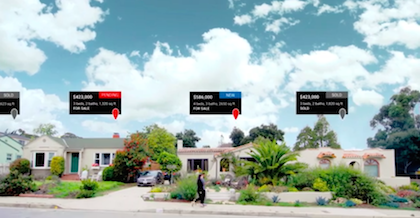Real Estate App Adds Augmented Reality, Image Recognition
Realtor.com beefs up its app with image recognition technology, augmented reality
By Rakin Azfar , January 18, 2017

The features are currently being tested
Online home buying resource realtor.com is test piloting a pair of new features on its application, Sign Snap and Street Peak, that make real estate data more accessible through image recognition technology.
The features are currently in different stages of development: Sign Snap uses image recognition technologies, as well as the smartphone’s camera and GPS capabilities to search the entire realtor.com property database, and is available now. Street Peak, which lets users pan a street and uses augmented reality to surface property details about homes on that street, is slated for release this spring.
“Sign Snap and Street Peek work for consumers who are actively looking for a home, as well as those who are casually browsing,” said chief marketing officer of realtor.com. “Sign Snap is great for someone who is in house hunting mode, and just drove by a great mid-century ranch house, but wants to know more about the property.
“Sign Snap allows users to access all of the property details including the number of bedrooms/bathrooms, price data and more, instantaneously in front of the house, and then share it with a significant other via email, text message or even social media,” he said. “We see Street Peek as a discovery tool.
“How many times have you driven down a street in a neighborhood you are not familiar with and wanted to learn more about a particular house as well as what’s nearby? In an urban environment, users can simply point their phone’s camera at a building and see what units are for sale, which ones are for rent, what other units sold for and more.”
New features
Users of the realtor.com app can now leverage the Sign Snap feature. Users can snap a photo of a real estate for-sale or for-rent sign they happen to be near and the Sign Snap feature will search the entire realtor.com property database to locate realtor.com property.
Through Sign Snap, users can now view related information for that property such as photos, property details, price data, open house dates, and can share desired listings with family and friends via email, text message and social media.

And in the spring, users of the app will be able to leverage Street Peek, where they can pan through a neighborhood street and look at property details through AR, even if the homes are not for sale. They can do this by simply framing a home or group of homes with the smartphone’s camera, and information from the realtor.com database will overlay the view, including listing or rental price, the recently sold price, estimated value, and the number of bedrooms and bathrooms.
Users can tilt the screen to view a map of the neighborhood and access additional perspective on what’s nearby, or tap the displayed info card to obtain more details. Filtering options let users locate specific property types, and users will be able to search their history of street photos and listings previously viewed.
iOS users excited about the new features are in for a bit disappointment, however: the features are only currently slated for realtor.com’s Android client—iOS availability is scheduled to follow at an undisclosed date.

Real estate on mobile
The real estate market has entered into the mobile space in a big way as of late. Realtor.com’s competitor Zillow recently rounded out a Online real estate marketplace Zillow is rounding out a year’s worth of mobile innovation with possibly its most splashy feature yet: an update to its flagship app that features iMessage App Store support (see story).
“It is important to bet heavily on mobile, and for good reason,” Mr. Johnson said. “Most searches begin and end online.
“According to the National Association of Realtors’ 2016 Home Buyers and Sellers, for 44 percent of recent buyers, the first step they took in the home buying process was to look online at properties for sale,” he said. “Many people wind up purchasing the home they first see online.
“Our mobile traffic is up 143 percent year-over-year, and the majority of our audience comes from mobile. Mobile devices are powerful; they can know who you are, where you are, how you’re moving, so they lend themselves nicely to the home search process. We are leveraging these capabilities to create optimized search experiences across Android and iOS.”
(25)

